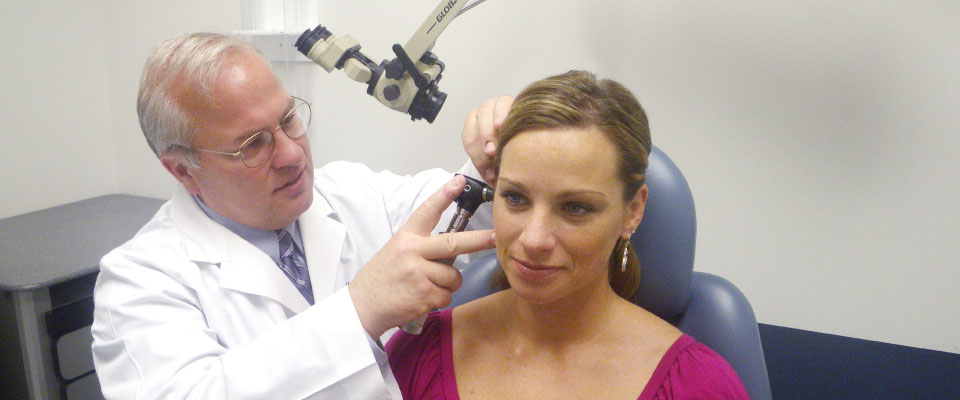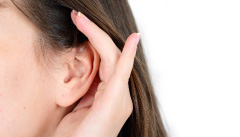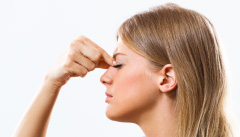Fine Needle Aspiration
Fine needle aspiration (FNA), also called fine needle biopsy, is a type of biopsy where a needle is inserted into a lump or mass to collect a sample of cells. These cells are then looked at under a microscope to help your doctor determine if the mass or lump is cancerous (malignant) or noncancerous (benign). Benign lumps may also be related to infection or inflammation. FNA can be performed on a variety of lumps that are either felt or identified on imaging tests (such as ultrasound or CT scan).
A few common reasons FNA is performed in the neck include:
- Nodules in the thyroid gland
- Enlarged or abnormal lymph nodes
- Neck cysts
- Lumps or masses in the salivary glands (i.e., parotid gland, submandibular gland)
Why is FNA Important?
A mass or lump may indicate a serious problem such as cancer. While many lumps are not cancerous, a biopsy is often needed to help determine this. FNA is frequently recommended because it is quick, has minimal discomfort, and can often be performed in the doctor’s office.
In addition to a biopsy, your doctor will ask you questions about your symptoms and history to help determine your risk of cancer. A few example questions may relate to weight loss, difficulty swallowing, smoking and drinking habits, and any personal or family history of cancer.
It is very important to note that, when found early, most cancers in the head and neck can be cured. Cancers that are caught early have the highest cure rates. So, play it safe! If you have a lump in your head and neck area, see your ENT (ear, nose, and throat) specialist, or otolaryngologist, as soon as possible for an evaluation.
What Happens in FNA?
A small needle is inserted into the lump to remove cells that are then examined under the microscope to make a diagnosis. Multiple sticks with the needle may be performed to get enough cells. If the lump is difficult to feel, an ultrasound device can be used to help direct the needle into the lump.
Local anesthesia (numbing medicine) may be injected into the skin over the area where the biopsy will be performed. Although not painless, the discomfort from FNA is usually minimal and can be treated with ice or Tylenol® if needed. Most often, the needle used for FNA is smaller than a needle used for a blood test from the arm (venipuncture).
Although no test is perfect, FNA is generally accurate and can often be used instead of an open surgical biopsy, which is usually more painful, costly, and may require the patient to be asleep.
Typically, the results from an FNA are available after a few days. These results may indicate a cancerous (malignant), noncancerous (benign), or indeterminate (uncertain) diagnosis. If the diagnosis is uncertain, your doctor will talk to you about whether another FNA or different type of procedure may be needed.
Are There Any Potential Complications?
No medical procedure is without risks, but complications from FNA are uncommon and usually minor. Some examples include:
- Sometimes the results of an FNA are inconclusive, in which case another FNA or a different type of biopsy procedure may be needed.
- Bleeding is the most common complication, although when it occurs, it is usually only a small bruise. Bleeding is more common in patients who take aspirin, Advil®, or blood thinners such as warfarin. You should let your doctor know if you are on any of these medications in case they need to be held prior to biopsy.
- Infection from FNA is very rare.
- Spreading a cancer with an FNA biopsy is very rare as the needle used is very tiny.
What Questions Should I Ask My Doctor?
- Can I eat before an FNA?
- Can I drive home after an FNA?
- Do I need to prepare for an FNA?
- Do I need to limit my activity after an FNA?
- Is there anything I should watch out for after my FNA?
Earwax (Cerumen Impaction)
Ears and Altitude (Barotrauma)
Ear problems are one of the most common medical complaints of airplane travelers and divers. While they are usually minor annoyances, sometimes they can cause significant symptoms. When the eustachian tube in your middle ear is blocked due to altitude or pressure changes (sometimes called barotrauma), air cannot be equalized, and a vacuum occurs. This stretches the eardrum and causes pain and occasionally fluid. The common cold, sinus infections, and nasal allergies can also interfere because swollen membranes in the nose can extend into the eustachian tube and block it (see “What Causes Barotrauma?” below).
What Are the Symptoms of Barotrauma?
Some symptoms of barotrauma include:
- Ear pressure
- Ear pain
- Hearing loss
- Dizziness
What Causes Barotrauma?
The eustachian tube is a membrane-lined tube about the width of a pencil lead that connects the back of the nose with the middle ear and helps maintain balanced air pressure on both sides of the eardrum. The most common cause of eustachian tube blockage is the common cold, but sinus infections and nasal allergies are also usual suspects. A stuffy nose leads to stuffy ears because the swollen membranes in the nose can extend into the eustachian tube and block it. Also, any situation in which rapid altitude or pressure changes occur, such as air travel, riding in an elevator, diving to the bottom of a swimming pool, or scuba diving, can affect proper function of the eustachian tube.
What Are the Treatment Options?
The simplest way to help clear your ears—particularly when flying—is to swallow. Yawning, chewing gum, or sucking on hard candy can help, especially just before take-off and during descent. You can also try pinching your nose, taking a mouthful of air, blowing gently (not forcefully) against your pinched nose, then swallowing. You’ll know if it worked when you hear a pop, and your ears feel less plugged.
Babies and children are especially vulnerable to ear blockage because their eustachian tubes are narrower than in adults. Plus, babies cannot intentionally pop their ears, but sucking on a bottle or pacifier can help. You and your children should avoid sleeping during descent because swallowing may not occur often enough to keep up with changes in air pressure.
If you have allergies, take your medications at the beginning of your flight. Over-the-counter nasal sprays or decongestants can also help air travelers to shrink the membranes and help the ears pop more easily. However, if you are pregnant, or have heart disease, high blood pressure, irregular heart rhythms, thyroid disease, or excessive nervousness, consult your physician before using these medications. Extended use of decongestant nasal sprays can also cause more congestion than relief, and even result in a type of addiction.
If your ears fail to open, or if you are experiencing persistent pain in your ears, seek the help of an ENT (ear, nose, and throat) specialist, or otolaryngologist. They may recommend inserting small pressure equalization tubes or a balloon to help dilate your eustachian tubes. Or, they may need to release the pressure or fluid with a small incision in your ear drum.
What Questions Should I Ask My Doctor?
- What can I do to prevent barotrauma from occurring?
- Who do I see if the pressure doesn’t resolve quickly?
Earaches
Earache, or pain in the ear, is common and can occur in both children and adults. It can be due to a problem with the ear or structures close to the ear. The pain may be dull, sharp, or burning and can occur in one or both ears. It may be constant or come and go.
What Are the Symptoms of Earaches?
Symptoms of earaches in infants and toddlers may include:
- Hearing problems
- Pulling or scratching the ear
- Crying or irritability
- Ear drainage
- Fever
Symptoms of earaches in young children, adolescents, and adults may include:
- Pain
- Hearing problems
- Full or “stuffy” sensation in the ear
- Dizziness or loss of balance
- Nausea, vomiting
- Ear drainage
- Fever
What Causes Earaches?
A variety of problems can cause earaches in children and adults:
- Middle ear infection (called acute otitis media)
- Swimmer’s ear (called otitis externa)
- Temporomandibular joint (TMJ) dysfunction or jaw joint pain
- Eustachian tube dysfunction
- Inflammation of the outer ear (called chondritis)
- Cotton swab use
- Throat infection
- Throat cancer (rarely)
What Causes Earaches in Children?
In children, earaches are commonly due to an infection of the middle ear (acute otitis media), and can affect one or both ears. Otitis media can be serious because the infection can spread to nearby structures in the head, especially the mastoid located behind the ear. Otitis media may also cause hearing loss; in children, it may impair learning ability and even delay speech development. However, if it is treated promptly and effectively, hearing can almost always be restored to normal.
Many cases of otitis media can be treated by your pediatrician or family doctor; more serious cases may need attention from an ENT (ear, nose, and throat) specialist, or otolaryngologist.
Ear infections are often due to eustachian tube dysfunction. Inside your ear you have something called an eustachian tube that equalizes pressure behind the ear drum and naturally clears middle-ear secretions. When the eustachian tube becomes blocked due to a cold, allergy, upper respiratory infection (URI), bacteria, or a virus, negative pressure can develop and mucus can collect behind the eardrum causing pain, swelling, and redness.
What Causes Earaches in Adults?
In adults, common causes of earaches include otitis externa or swimmer’s ear and TMJ dysfunction. Swimmer’s ear is an infection of the ear canal and results from swimming in contaminated water or as a result of cotton swab use. In people with diabetes, otitis externa can spread far beyond the ear canal and can be life threatening. Therefore, prompt treatment with antibiotic ear drops as well as cleaning of the ear canal with specialized tools available to an ENT specialist is critical. Another common cause of ear pain is due to referred pain from the jaw joint. This is usually due to grinding of teeth during sleep. TMJ pain can be treated with ibuprofen, eating softer food, avoiding chewing gum, and using a night guard.
An avoidable cause of earache is the use of cotton swabs or other instruments to clean wax from the ear, which can damage the ear canal. Following the old adage that “nothing smaller than an elbow goes in the ear” can avoid dangerous injury to the ear canal and the eardrum. A rare cause of earache is referred pain from infection or cancer of the throat.
What Are the Treatment Options?
During an examination, your ENT specialist will use an otoscope to look inside and assess your ear. They check for redness in the ear, and/or fluid behind the eardrum, and to see if the eardrum moves. These are the signs of an ear infection. If your hearing is decreased, your ENT specialist may also perform an audiogram to test for any potential hearing loss by presenting tones at various pitches, or a tympanogram, which measures the air pressure in your middle ear to see how well your eustachian tube is working.
Your ENT specialist may also prescribe medications, which must be taken as directed. Often, antibiotics to fight the infection will make your earache go away rapidly, but the infection may need more time to clear up. Other medications that your doctor may prescribe include an antihistamine (for allergies), a decongestant (especially with a cold), or both. Sometimes the doctor may recommend a medication to reduce fever and/or pain. Special ear drops can also help ease the pain.
Children who experience multiple episodes of acute otitis media within a short time, chronic otitis media that lasts for more than three months, and/or hearing loss may require the insertion of ventilation tubes, also called pressure-equalization (PE) tubes. This is a short surgical procedure in which a small incision is made in the eardrum, any fluid is suctioned out, and a tube is placed in the eardrum. This tube will eventually fall out on its own, and the eardrum heals.
Remember, without proper treatment, damage from an ear infection can cause chronic or permanent hearing loss as well as more severe infections to the surrounding important structures.
What Questions Should I Ask My Doctor?
- How can I avoid earaches in the future?
- How do I clean my ears?
- Can my eustachian tube function be improved?
- Are ear tubes recommended for preventing ear infections?














